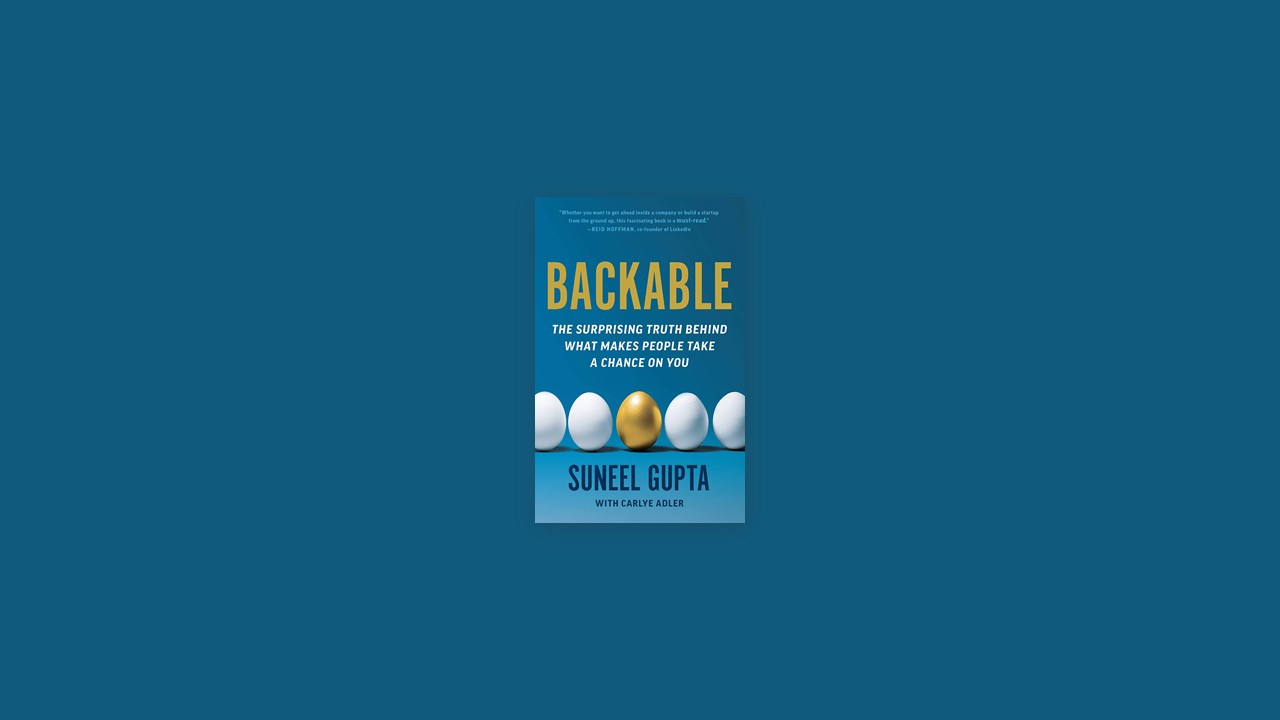No one makes it alone. But there’s a reason why some people can get investors or bosses to believe in them while others cannot. And that reason has little to do with experience, pedigree or a polished business plan. Backable people seem to have a hidden quality that inspires others to take action. We often chalk this up to natural talent or charisma . . . either you have ‘it’ or you don’t.
After getting rejected by every investor he pitched, Suneel Gupta had a burning question: could ‘it’ be learned?
Drawing lessons from hundreds of the world’s biggest thinkers, Suneel discovered how to pitch new ideas in a way that has raised millions of dollars, influenced large-scale change inside massive corporations, and even convinced his 8-year-old daughter to clean her room.
Step 1 | Convince Yourself First
What moves people isn’t charisma, but conviction. Backable people earnestly believe in what they’re saying, and they simply let that belief shine through whatever style feels most natural. If you don’t truly believe in what you’re saying, there is no slide fancy enough, no hand gesture compelling enough, to save you. If you want to convince others, you must convince yourself first.
You don’t need personal history in order to feel personal passion. But your idea needs to strike an emotional chord. Davis Guggenheim, the Oscar-winning director of An Inconvenient Truth and Inside Bill’s Brain, said “we all have different voices in our head.” He says his “clever voice” is always saying things like “that’s a cool shot” or “no one’s ever done that before.” But Guggenheim says he does his best to tune out his clever voice and tune in to how an idea makes him feel. “If something keeps me up at night. If something makes me angry or makes me cry…those raw instinctual attachments have never let me down.”
So, as you’re figuring out whether an idea fits you, ask yourself if you’ve fallen in love with it. And as you dig in deeper, keep checking in with your elephant, paying attention to whether new challenges are fueling you or depleting you.
Step 2 | Cast A Central Character
As individuals, we’re wired to care about the stories of individuals. This goes back to life around the campfire—it’s in our DNA. When a movie makes us emotional, it’s typically because we feel connected to a specific character—rather than the ensemble.
This is why a reporter will cover a trend through the eyes of one person. Trish Hall, a former op-ed editor at the New York Times, says, “You don’t go into journalism without feeling like facts change the world.” And yet, Hall says, “facts alone will not change people’s minds. Emotions and feelings are just as important, probably more important.”
Bill Gates once showed his daughter a video of a young girl with polio. The girl was holding a pair of dilapidated wooden crutches and trying to walk down a dirt road. After watching the video, his daughter turned to her father and said, “Well, what did you do?” Gates told his daughter his foundation was eradicating polio. He shared the numbers with her—the hundreds of millions of dollars they were deploying, the goals they’d set, and the metrics they’d already hit, including shrinking the number of cases in Nigeria from seven hundred per year to fewer than thirty. “No, no, no,” interrupted Gates’s daughter. She pointed back to the video and asked, “What did you do for her?”
Great storytellers don’t just focus on a central character, but also a central reader. Instead of addressing millions of people, they’ll imagine they’re sharing the story with one specific person.
Step 3 | Find An Earned Secret
How you arrive at an idea can be as important and meaningful as the idea itself.
So when you’re sharing the insight that led you to your idea, ask yourself, Is this google-able? If it is, then take your research deeper. Set up interviews with experts, take a trip, join a nonprofit that’s relevant to your idea. If you’re interested in cryptocurrency, don’t just read a report; set up an account and start making trades. If you’re interested in autonomous vehicles, don’t just subscribe to a newsletter; visit a factory, drive a car. If you’re interested in cannabis, well…in a growing number of states you now have options.
Go beyond Google. That’s where the secrets lie.
Once you’ve gone beyond Google, make sure your pitch demonstrates your effort. Don’t share just your idea, but the effort as well—the work you did in the field that brought you to it. This might sound obvious, but it’s often missed.
Step 4 | Make It Feel Inevitable
Daniel Kahneman won a Nobel Prize for helping the world understand how we make decisions. One of the key underpinnings of Kahneman’s contribution is what scientists call “loss aversion,” which suggests that, psychologically, the pain of losing is twice as powerful as the pleasure of gaining. Kahneman points out that most people will “reject a gamble in which they might lose $20, unless they are offered more than $40 if they win.
Loss aversion can help us understand a lot about our colleagues, our friends, and ourselves. It helps us understand why a driver with no history of car accidents pays Avis extra for collision insurance. It helps us understand why someone holds on to a downward-trending stock so that the paper loss doesn’t turn into an actual loss.
And it can also explain why backers are reluctant to invest in anything that doesn’t feel safe. Even venture capitalists who look for risky investments turn down the overwhelming majority of new ideas they hear. Instagram, Facebook, and Amazon were rejected by multiple investors.
If the fear of betting on the wrong idea is twice as powerful as the pleasure of betting on the right idea, then we can’t neutralize the fear of losing with the pleasure of winning. We can only neutralize the fear of losing with…the fear of losing.
Enter FOMO, the fear of missing out. For backers, the only thing equally powerful to missing is…missing out. No one wants to be the Hollywood studio that passed on Star Wars, the university that rejected Albert Einstein, or the executive at Blockbuster who passed on buying Netflix for $50 million.
We see FOMO play out everywhere. Once a founder has a lead investor, other investors want to join the round. Once an employee has a competing job offer, he or she is much more likely to receive a raise. Once a real estate agent has an offer, he’s more likely to attract other offers.
Step 5 | Flip Outsiders To Insiders
Most great political speeches include three stories: the “story of me,” “the story of you,” and most important, the “story of us”—what happens when we join forces and work together. John F. Kennedy’s inaugural speech masterfully did this when he laid out a bold agenda and then challenged people everywhere to ask what “together we can do for the freedom of man.”
Backable people highlight three steps to showing backers they are a pivotal part of your plan.
First, identify a gap in your idea that relates directly to a strength in your backer. A gap could be anything from needing to figure out the right marketing strategy to hiring the right people.
Second, learn as much as possible before your meeting. Although you will be highlighting a gap, you still want to be able to engage your backer with the right questions and discussion. This takes preparation.
Finally, when you meet with your backer, be sure to directly express the “story of us.” Explain how your gap and their strength fit together to unlock your idea. Don’t assume that they’ll connect the dots. Even if they do, it’s worth them knowing that you understand why you two fit well together.
Step 6 | Play Exhibition Matches
In February of 1960, Ella Fitzgerald sang “Mack the Knife” to a large crowd in West Berlin. The song was popularized by artists like Bobby Darin, Louis Armstrong, and Frank Sinatra, but this was the first time the crowd had heard a woman sing it. It was a special moment in musical history that was almost ruined when halfway through Fitzgerald forgot the lyrics.
But instead of stopping, Fitzgerald kept singing, playfully, joyfully inventing new lyrics as she went. The crowd roared in appreciation, and the recording earned her Best Female Vocal Performance at the Third Annual Grammy Awards in 1961.
If you play enough exhibition matches, you’ll start to see patterns in the feedback. Sometimes you’ll come to the realization that your entire pitch isn’t working. Instead of throwing away your dream, have the courage to reboot your style and begin again. Nearly every successful person has done this. Want proof? Search for an old speech of someone you admire and notice how their communication style has changed.
Looking back, Obama says that it was losing an election tat showed him how to win. “It taught me the importance of campaigning not based on a bunch of whitepapers and policy prescriptions but telling a story,” he said. That wisdom helped rebrand Obama from neighborhood politician to a national leader. But none of that would have happened had he not been willing to reinvent his own style.
Step 7 | Let Go Of Your Ego
When you walk into a room to present your idea, the spotlight is on you. Your job is to turn that spotlight away from you and toward your message.
There’s a difference between customizing your pitch and shoehorning it into something it’s not. Even if the shoehorning works and the backer says yes, it almost always leads to issues downstream. Investors pull out when the roadmap isn’t what they expected. Films get axed in post-production because there wasn’t a shared vision in pre-production. R&D projects get derailed in phase 2 because the vision wasn’t fully expressed during phase 1.
Call To Action | The Game Of Now
Every backable personat some point in their career, learns to play the Game of Now. When Brian Grazer was trying to break into Hollywood, he convinced Lew Wasserman, one of the industry’s most influential rainmakers, to give him some career advice. Two minutes into the meeting, while Grazer was sharing his background, Wasserman interrupted and said, “All right, enough! Pull out a piece of paper.” Then Wasserman told him to start writing—to stop talking about writing, and just write. That piece of paper led to Splash, starring Tom Hanks, and Grazer soon after formed Imagine Entertainment with Ron Howard. He looks back at that single act—writing down his idea—as a moment that would define his career. The moment he began to play the Game of Now.
Mahatma Gandhi said, “The difference between what we do and what we are capable of doing would suffice to solve most of the world’s problems.” Now, more than ever, we need good people to stop playing the Game of Someday and start playing the Game of Now. That begins with you.
The craziest ideas—the ones that are most likely to change the world—are often the hardest ones to sell. But that doesn’t mean we stop trying. We build the skills and invest the energy to make ourselves backable. And we realize, as all backable people eventually do, that when you get dismissed, there is always another room.


